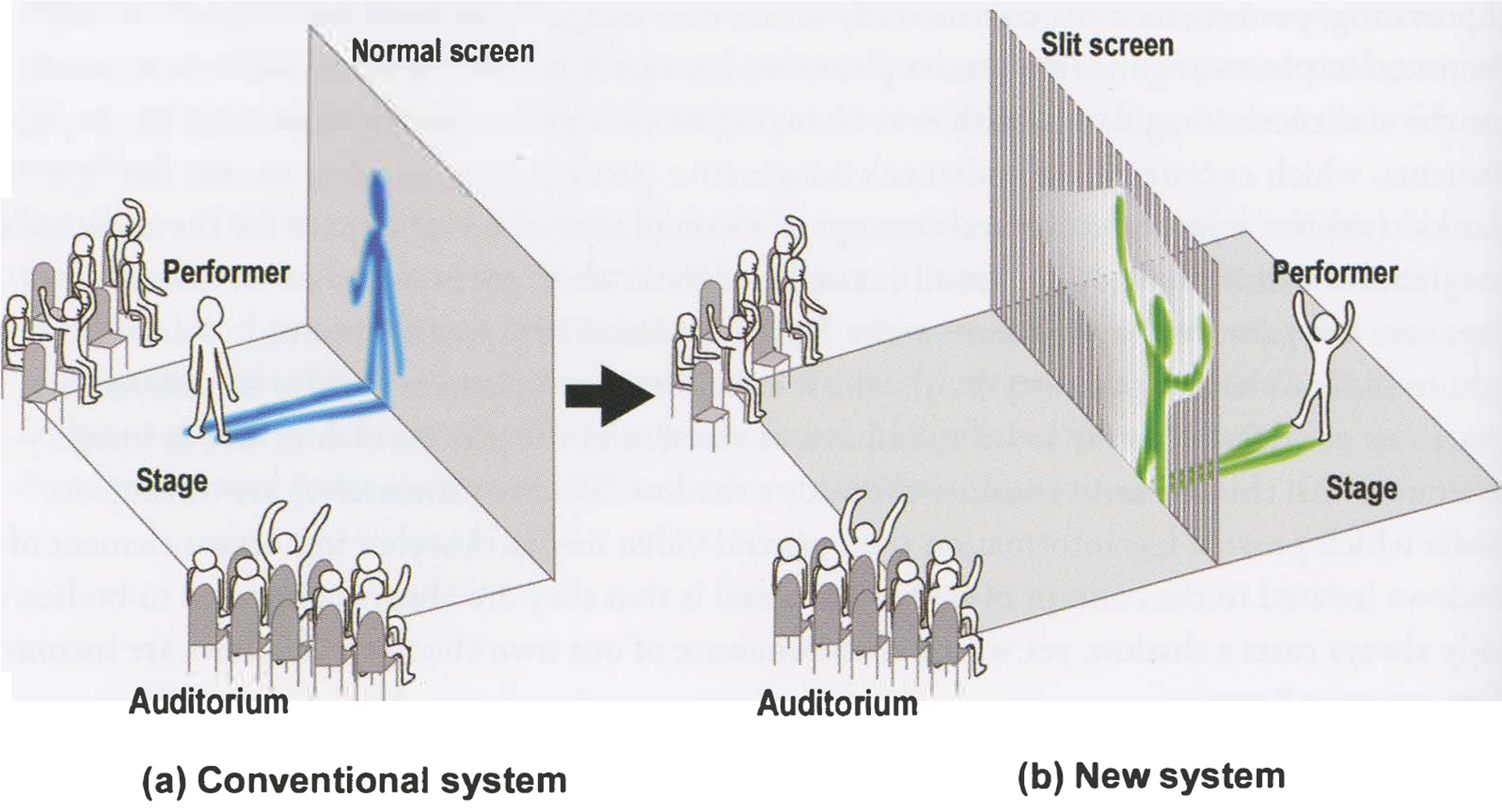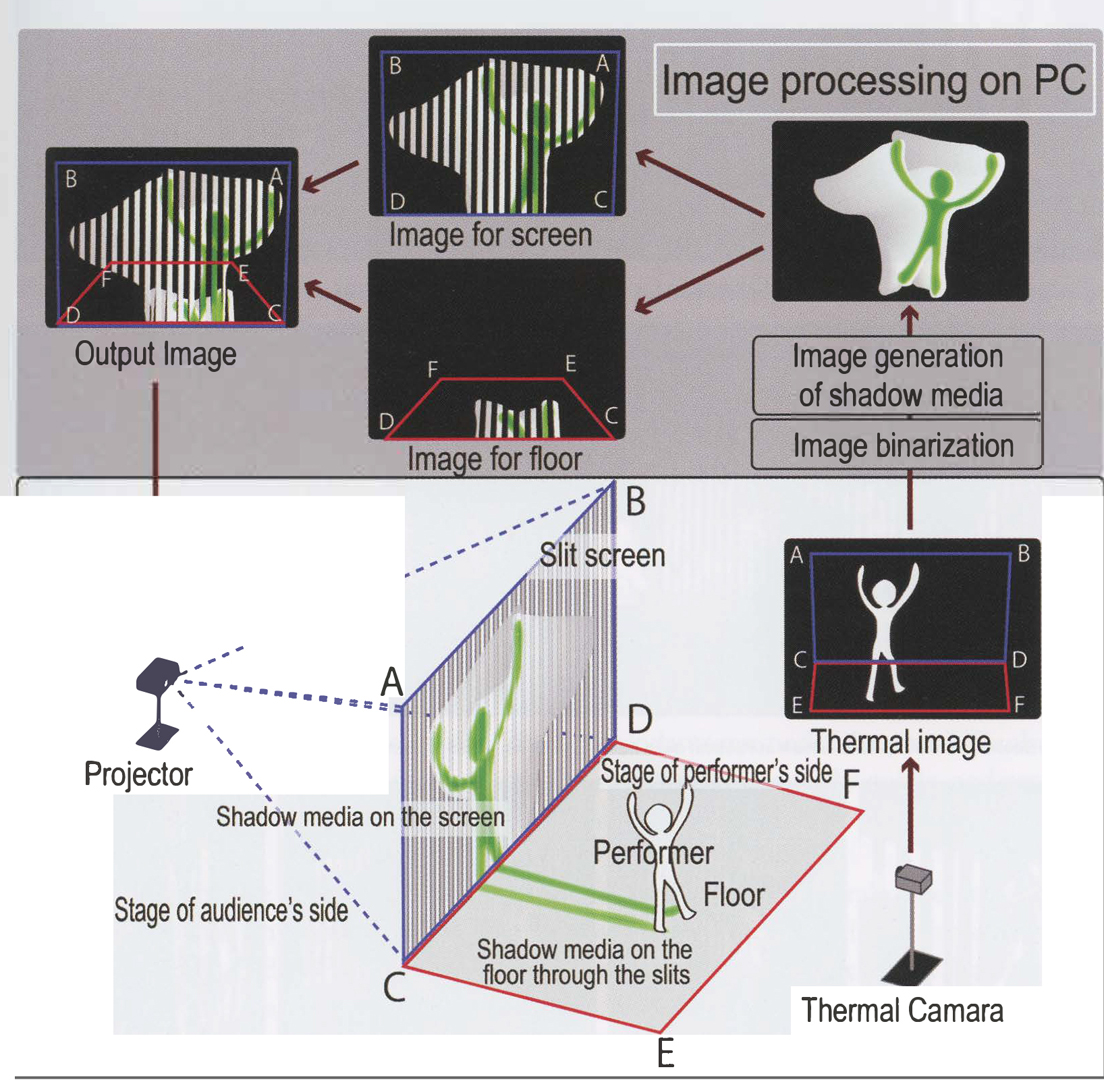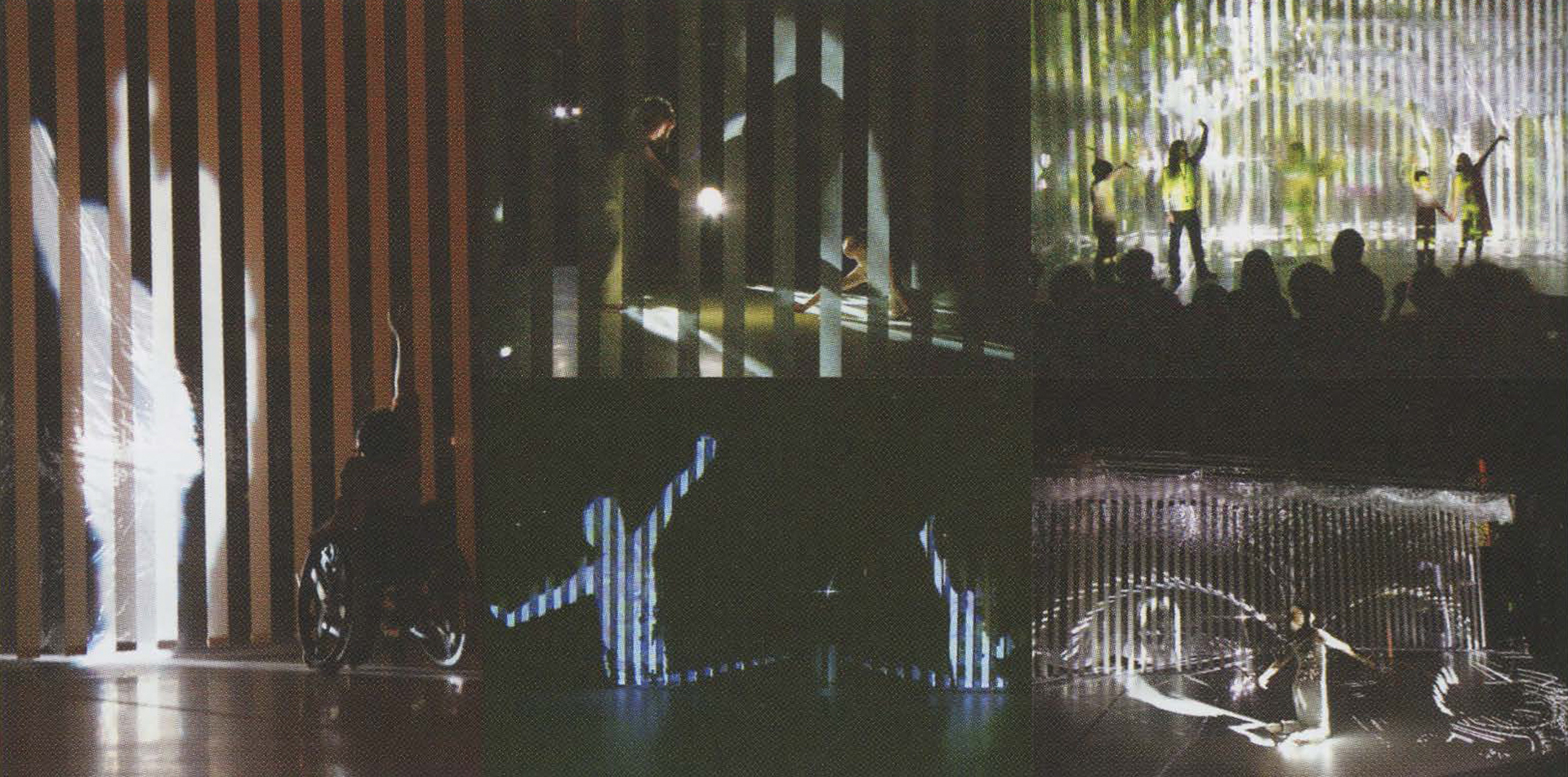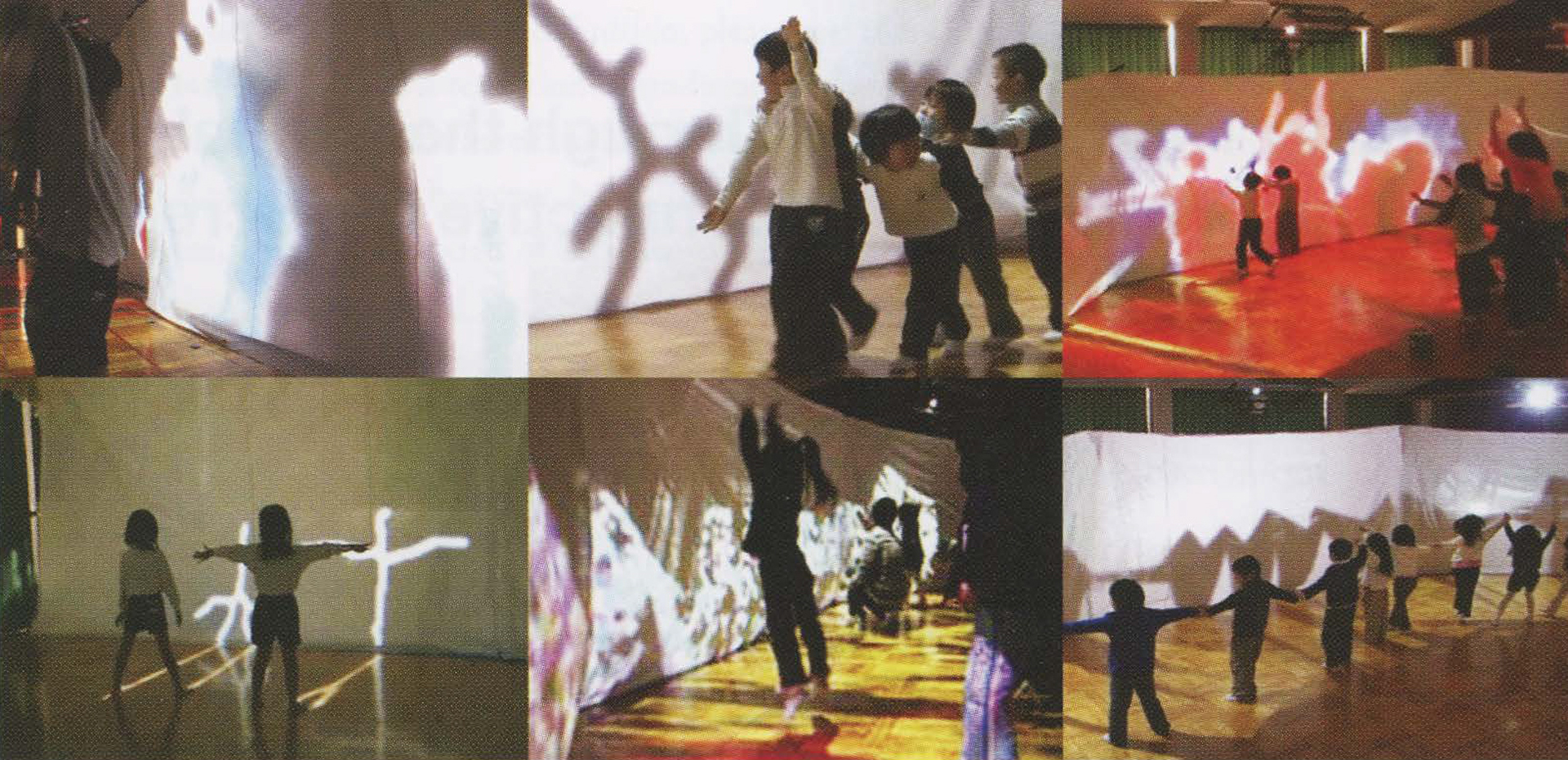Yoshiyuki Miwa, Shiroh Itai, Takabumi Watanabe, Hiroko Nishi: Shadow Awareness
Artist(s):
Title:
- Shadow Awareness
Exhibition:
Creation Year:
- 2011
Medium:
- Live performance and projection
Category:
Artist Statement:
This study discusses media technology that enables the continuous creation of performers’ physical improvisation as inspired by the reflection of imagery evoked from the audience. To realize this, the authors have focused on “shadow media,” which promote the continuous creation of imagery through “bodily awareness.” The authors have developed a system that can project shadows of the performers in various ways, which are then transformed into various shapes and colors. The shadows are connected to the performers’ feet and projected on a “passable” slit screen set up between the stage and the audience. As a result, the interactive and mutual creation of imagery by performers and audience can form an “empathetic” stage. To demonstrate its validity, the authors applied the system to a dance performance at Festival della Scienza in Genoa, Italy
Technical Information:
This section describes the system used for projecting the shadow media on the slit screen. As seen in Figure 3, this system can project shadow media on the slit screen in a variety of ways. The basic shadow media projection method projects the shadow media of a person standing in the performer’s stage space. The system’s structure is shown in Figure 4. First, the system creates the shadow media by acquiring a thermal image via a thermal camera located at the back of the stage, extracting the body’s region, which has a different temperature from the surroundings, and processing this image with a computer. Assuming that the shadow media’s light source is located in the position of the thermal camera, projecting this shadow media onto the performer’s feet ensures a geometric consistency between the body shape and the shadow media. In this case, to avoid having the performer’s actual shadows projected on the slit screen, the projector is
situated on the side of the audience, and the shadow media stretching from the performer’s feet must be projected onto the screen as well as the stage floor beyond the screen. The projected image must be divided into two sections: one projected onto the screen, and the other onto the stage floor. Each section is subjected to projective transformation for projecting on the screen or on the stage floor. In other words, the projected image is a composite of two images with alternate vertical stripes (Figure 4). This composite shadow is projected from the audience’s side. The slit screen is made of polyester, which enables rear projection. Thus, this system can simultaneously project shadow media on the floor (to recreate a shadow stretching from the performer’s feet) and on the slit screen. Although the shadow media system developed in the past had to be installed on the ceiling as a projecting source, the current projecting method does not require
installation of projectors on the ceiling. This is quite beneficial because it halves the number of projectors required. Furthermore, as mentioned above, we can project the audience’s shadow media by bilaterally and symmetrically arranging the new shadow media projection system with a central focus on the slit screen.
Process Information:
This study discusses technology that promotes an interactive relationship between performers and their audience; enables performers to create physical expressions while expanding their range of imagery through reference to their shadows and in reaction to the audience’s existence and influence; and enables the audience to generate their own imagery through the shadow media while reacting to the performers’ existence and influence. In order to achieve such results (Figure 2b), it is necessary for performers and audience to face each other so that each of them can share the shadow media. In order to maintain the inseparable relationship between a body and its shadow media, the projected shadow media is connected to the performers’ feet so that it looks like their actual shadows. Projecting a silhouette image on the screen, disconnected from the body, would not be enough. One method by which the audience and the performers can share the shadow media while facing each other is to install a transmissive screen, which is made of a material, such as scrim or fabric, that allows the background of the stage to be seen, at the border between the stage and the audience. However, this method has a few problems: the
projection on the screen shines through the screen itself and gets cast on the stage floor, and the shadow media that is intended to be projected only on the stage floor to show shadows connected to the performer’s feet (for maintaining the inseparable relationship between body and shadow) appears on the screen. Therefore, we used a screen with vertical slits (Figure 2) to project the shadow media from the audience’s side. This slit screen allows the projection of each individual image to be cast separately on the reed-textured screen (slit screen) and the floor (passing through the slits), which solves the problems mentioned above. This shadow media projection method also offers the following three advantages: (r) The audience can not only see the performers’ projected shadow media, but also their bodies through the slit screen. (2) Performers and audience can move back and forth on each side of the stage through the physical gaps in the
slit screen. This enables the inseparable integration between performers and audience. (3) Perceptual completion enables performers and audience to see the incomplete image on the slit screen as one cohesive shadow medium, although the image of the shadow media is fragmented
(sliced) by the splits. As shown in Figures 3a and 3b, thermal cameras and projectors placed on both sides of the slit screen to generate shadow media enable performers to pass through the slit screen and to create physical expressions through the shadow media generated on the auditorium and the stage floors. The audience can also participate in an ongoing performance (or enter the stage of physical expressions created by performers – “shadow media space”) with their own shadows. This means that performers and audience can encounter and interact with each other through the use of shadow media. This system also makes it possible to project an image across the entire theater, including the walls and the ceilings above the stage and the auditorium enclosing the entire stage and auditorium in the image (Figure 3c). The slit screen can expand the stage to the entire theater. Finally, the stage and the auditorium can be integrated. Furthermore, as seen in Figure 3d, not only the shadow media, but also the performers’ actual shadows can be simultaneously projected on the screen. Additionally, by projecting different shadow media from two projectors, the superimposed (dual) shadow media can be projected on the screen (Figure 3e). In comparison to the existing system (Figure 2a), our method expands the range of physical expressions through the use of shadow media. Thus, this system can be considered as an example of Eastern interactive media art. It projects shadow media on the slit screen which will bring about a spatial expansion and a sense of depth. In other words, this system provides yohaku, which is often seen
in suiboku-ga Japanese ink paintings, enabling the audience and performers to create imagery together.In general, interactive art that invites audience participation has focused on supporting direct interaction between an audience and a fixed artwork [6-ro]. It has focused attention on the relationship between audience and artwork [rr]. Myron Krueger, the famous researcher of interactive art, originated the focus on the relationship between performers and audience [12]. He argues that art’s future direction is art created by the interaction between performers and audience. He proposes that performers interact with the audience by projecting silhouettes of both performers and audience in the shared visual environment of the video space he developed. However, in his concept, the space where performers and audience interact is virtual – shared, but only virtual – not a shared real environment. There are many technologies, such as those often used in traditional stage settings, that heighten performers’ expressions by applying a special effect to either the stage space or the performer [13-16]; or that inseparably enhance the audience’s rapport with the performers, such as waving penlights at concerts. In contrast, our
new system, which enhances the relationship between performers and audience through their physical interactions in a real space, is the first attempt of its kind in the technological media field. This study attempts to apply technology to achieve interaction through shadow media that can stimulate the audience and performers to create images collaboratively. Shadow media are widely used in the human-interaction field to support interaction between humans. For example, there is the remote communication system (WSCS) [17] that enables the positioning of oneself and a remote partner in one’s own physical location by exchanging the physical shadow of both participants between remote locations, and projecting the mutual shadows from each participant’s location. The WSCS interaction system generates a situation where, in effect, the participants are actually talking to each other face-to-face. There are also several research programs, such as Passages (Bitton), that attempt to support remote communication by projecting the shadow silhouettes of remote participants on a screen [18]. The Palindrome dance company has conducted performances using performers’ shadows to enhance their physical expression [19]; and Lozano-Hemmer has presented an installation in which a video image emerges from one’s own shadow in an outdoor space [20], demonstrating that participants can play improvisationally with the help of their shadows. As a result, he successfully transformed a space that people pass through into a space where they meet and play. Among these projects in other arts, our research will be the first use of shadow media to position an audience on the stage and support the co-creation of the image, focusing on the relationship between performer and
audience.











